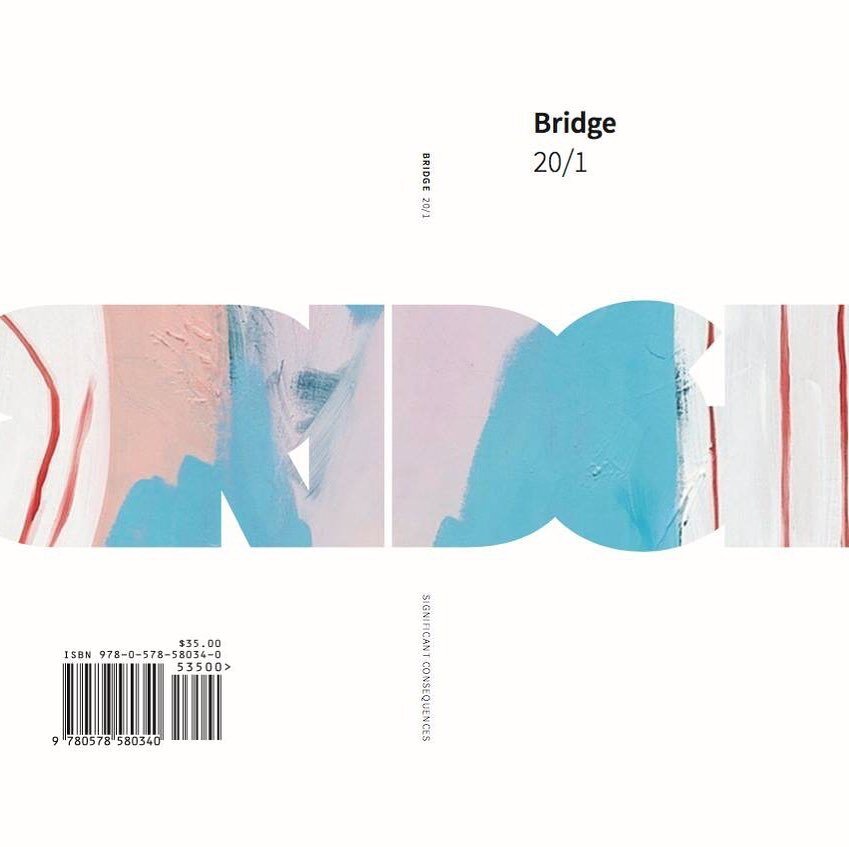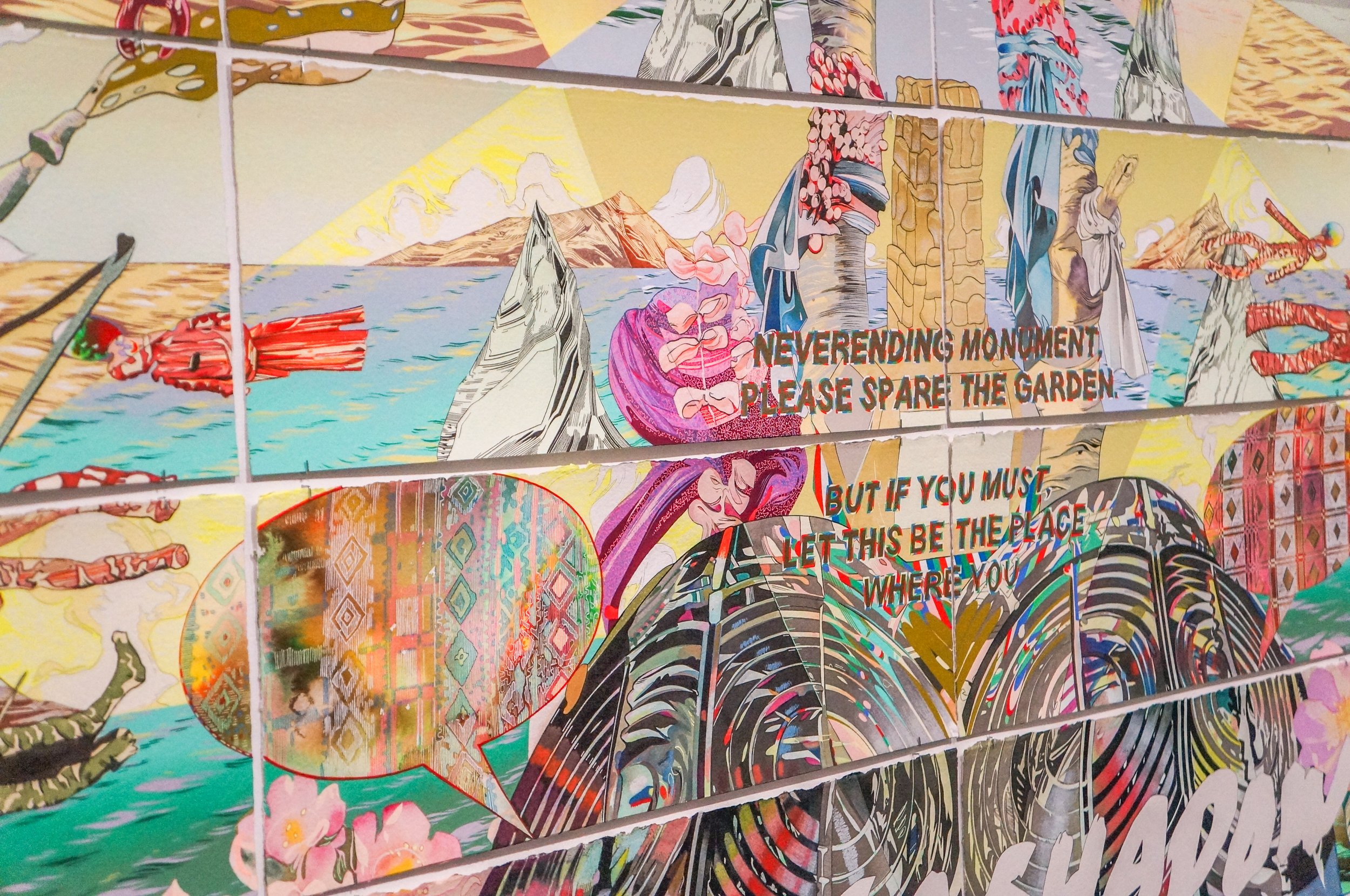REVIEW: Filling the Absence in the Landscape: Andrea Carlson, “Shimmer on Horizon” at the MCA Chicago
Cast a Shadow (detail), 2024. Oil, acrylic, gouache, ink, colored pencil, and graphite on paper. Andrea Carlson. Photo by Xiao daCunha.
REVIEW
Andrea Carlson, Shimmer on Horizon
MCA Chicago
220 East Chicago Ave.
Chicago IL 60611
Aug 3-Feb 2, 2024
By Xiao daCunha
Andrea Carlson speaks gently in a short documentary for her exhibition at the MCA: “Historically, landscape painting is violent. It’s about possession of the land, even though it might be plastered over with beautiful lighting and vast views: it’s based on empty landscape. Well, how did the landscape get emptied?”
Andrea Carlson: Shimmer on Horizon is the latest of MCA’s Chicago Works series. In this exhibit, the artist invites the viewer to investigate the dehumanizing nature of landscape paintings, which excavate the surroundings of their memories, identities, symbols, culture, creatures, people, heritages, and histories.
Landscape paintings hold a special romantic position in art history. The wall paintings in the Greek and Roman eras captured the marvels of the great empires, followed by religious paintings using the forests and creeks as the backdrop of divine encounters. In the 16th century, the landscape began to be regarded as an independent subject, corresponding to the rising interest in the natural world during the Renaissance era. Classical landscapes, modernist landscapes, impressionist landscapes, even photography…the sceneries have changed, but some characteristics of landscape art remained painfully cohesive: the brutal suspension of the land into statisity.
Hydrologic Unit Code 071200 — Nibi Ezhi - Nisidawaabanjigaade Ozhibii’igeowin 071200, 2022. Five-channel video installation (color, sound). Andrea Carlson and Rozalina Borcila. Photo by Xiao daCunha.
In traditional landscape paintings, the land is ripped out of its context and frozen onto the canvas: sometimes appropriated for the sake of spirituality, other times isolated from the vast community, biodiversities, ecological and civil developments that together define the essence of the landscape. The landscape is treated as an inanimate display without a future or past. They are as meaningful as they are meaningless, where each leaf, hill, rock, and stream is shrouded by pretty colors and advanced techniques. They are beautiful and magnificent but hollow.
A sense of absence prevails.
Carlson’s work fills this absence and restores the landscapes to their fullest selves by weaving and layering what the land has witnessed into her creation.
In Hydrologic Unit Code 071200, a five-channel video installation, Carlson interweaves footage of wetland banks, public signages in the area, and historical texts on US colonial expansions. The videos dive into a shameful history in the real estate investment market, where wetland credits are purchasable by investors as a way to compensate for the debts incurred by destroying wetlands elsewhere. The credits were generated by wetland banks: manmade wetlands restored, manufactured, or enhanced for investment purposes. The videos flickered, each set of image strips playing according to timestamps from the original footage they were taken from, with text occasionally flashing through: “colonialization European to the Chicago moves to the U.S.” The hydrologic, or the colonialist’s logic, is that creating Wetland banks could compensate for the natural wetlands on the Indigenous lands—that it was justifiable to rip someone else’s land open and move on from the pain and destruction done onto someone else’s landscape so long some sort of restorative effort was done elsewhere. Does the logic stand, or is it a false equivalence? Hydrologic Unit Code 071200 forces the audience to see beyond the mesmerizing Wetland Banks and confront the natural wetlands that were dried into real estate.
Installation view of Chicago Works: Andrea Carlson at the MCA. Photo by Xiao daCunha.
A similar interwovenness is also manifested in Carlson’s prismatic paintings, where the artist adopts film strip formats to simultaneously capture a landscape at multiple moments throughout history and seasons. In Perpetual Care, Carlson added references from Mondo Cane, the exploitation film that frequently fabricates global cultural practices for comedic purposes. The painting also includes personal artifacts and references, such as Carlson’s hands, a horse made by her great-grandaunt, and the classic red, white, blue, and black L’Assomption sash (Metis Sash) pattern, referring to Carlson’s heritage. The end result is a multilayered image that exits across multiple eras, like films taken from timestamps overlapping each other. It is almost impossible to separate the land from the motifs, but isn’t that the point? The land bore witness of the past and will continue to witness the future. This was the land that fell victim to invasion and capitalist greed. However, this also was and will continue to be, the land that nurtured generations of Indigenous presence and resistance.
As Heraclitus so timelessly put it: “No man ever steps in the same river twice, for it's not the same river, and he's not the same man,” the landscapes captured in these pieces exist ubiquitously throughout time, yet are also nowhere to be found in reality because they have long changed and will continue to change. Guided by the Anishinaabe understanding of space and time — Indigenous temporalities enmeshed with the land, Carlson’s landscape art embraces the fleeting nature of the living experience and forgoes all control or attempts to capture the landscape in the moment. By bringing the ongoing erasure and depression to the surface, Carlson invites the community to remake and reimagine what was lost and removed, physically or metaphorically, from the land so it can be regained by future generations: through commemoration, the path to renewal is paved.
Perpetual Care, 2024. Oil, acrylic, gouache, ink, colored pencil, and graphite on paper. Andrea Carlson. Photo by Xiao daCunha.
At least, that’s what Casting a Shadow portrayed: a relentless and hopeful community ready to march forward while carrying their ancestors’ pain. In the center of the painting is a bolded, all-capped message:
“NEVERENDING MONUMENT,
PLEASE SPARE THE GARDEN
BUT IF YOU MUST
LET THIS BE THE PLACE
WHERE YOU”
Where you…what?
Do you mourn? Do you grieve? Do you remember? Do you celebrate?
Standing in front of the shadowless, floating monument1 surrounded by toys, games, trinkets, patterns, and other culturally and emotionally significant objects in a piece titled “Casting a Shadow,” one couldn’t help but wonder: perhaps we are the missing shadow from the monument, a manifestation of what was taken and what remained.
We will continue to fill the absence in the landscape as a form of decolonization, sowing seeds atop memories, taking up space to create a fresh presence —
— and the land shall be our witness.
1. The monument in Casting a Shadow is a reference to a drawing by late artist George Morrison (Grand Portage Ojibwe; b, 1919, Chippewa City, Mn; d. 2000, Grand Marais, MN) of a proposed tombstone that was never realized.
Xiao daCunha is a writer and artist living in Chicago and Kansas City, Missouri.
Like what you’re reading? Consider donating a few dollars to our writer’s fund and help us keep publishing every Monday.






